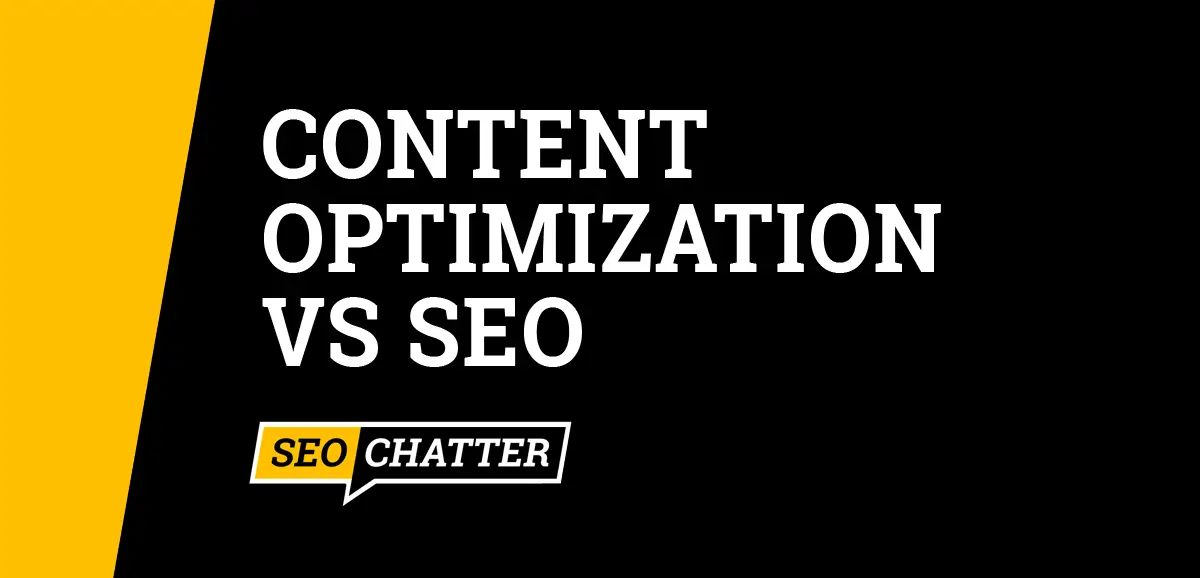This search engine optimization (SEO) guide covers content optimization vs SEO.
As you’ll discover below, SEO and content optimization have separate purposes for search engines and website users. And knowing the difference between content optimization and SEO will help you understand how to use each technique correctly to increase your website’s organic traffic and rankings in the search engine results pages (SERPs).
There’s also a section with additional digital marketing resources that explain more about the fundamentals of SEO and content optimization to help you create the most effective search engine optimization strategy.

What Is the Difference Between Content Optimization and SEO?
The main difference between content optimization and SEO is that content optimization refers to optimizing all aspects of the content to meet key digital marketing goals while SEO only focuses on search engine optimization for higher rankings and visibility in the SERPs.
Content Optimization vs SEO Comparison
The comparison table below shows the key differences between content optimization and SEO in an easy to understand format. After the table, I’ll explain each factor individually.
| Parameter | Content Optimization | SEO |
| Definition | The practice of optimizing all aspects of content so it satisfies users and search engines. | The practice of optimizing technical aspects of a website to make it better crawlable and indexable. |
| Primary Purpose | To improve content to help meet key digital marketing goals. | To increase organic search engine visibility. |
| Application | Specific Content | Sitewide |
| Types | On-page SEO, Content Quality, User Search Intent, Image Optimization, Structured Data, Backlinks, and Conversions | On-Site, Off-Site, Technical, Local, International, and Mobile |
| Marketing Goals | SERP Rankings, Backlinks, Shares, and Conversions | Indexing, SERP Rankings and Backlinks |
What Is Content Optimization?
Content optimization is the process of making sure content is written and optimized in a way that satisfies both users and search engines. Good content optimization includes on-page SEO techniques, writing quality content, meeting user search intent, optimizing images, using Structured Data, generating backlinks, and optimizing for conversions.
Types of Content Optimization
On-Page Optimization
On-Page optimization is the practice of optimizing web page content for search engines by using keywords in specific HTML locations like the meta tags, header tags, body content, internal link anchor text, and page URL. On-page SEO also focuses on improving keyword prominence and keyword frequency for search engines to accurately index and rank the content in the search engine results pages for relevant queries.
Content Quality Optimization
Optimizing content quality is an important factor for content optimization because it impacts user engagement. If the content is not well-written, factually correct, or relevant, then users will not stay on the web page for long and may not return to the website in the future. Optimizing the content quality also helps build trust with users which can lead to more shares, backlinks, and trust signals that Google’s algorithm (and other search engines) analyze for ranking purposes.
User Search Intent Optimization
User search optimization refers to optimizing content so it meets the purpose behind a user’s search query. Understanding user search intent is essential for creating content that accurately addresses the user’s needs and helps them achieve their goal online. A common mistake website owners make is a mismatch between the user search intent and content that’s written and displayed on the web page, which heavily affects the rankings in the SERPs.
Image Optimization
Image optimization is also part of content optimization because images affect the page load speed and are indexed by search engines. Optimizing images consists of compressing the files to make them smaller and load faster as well as adding keyword-rich text to the image ALT text, filename, and metadata information.
Structured Data Optimization
Structured Data optimization improves content by making it easier for search engines to understand and index. Structured Data optimization includes adding Schema Markup to the HTML source code page to provide search engines with additional information about the content so it can be organized and indexed correctly in the SERPs. Schema Markup also enhances a web page’s listing in the SERPs by displaying rich results.
Backlink Optimization
Backlink optimization consists of adding key elements to the content that make it more linkworthy and shareable. Examples include adding statistical data, facts, videos, graphs, charts, infographics, etc, that other website owners will want to link to from their own content.
Conversion Optimization
Conversion optimization is another important part of the content optimization process because every web page should have a specific conversion goal in mind. By optimizing the content around that goal, you can increase the number of leads, customers, and sales your business receives. There’s no point in ranking high in the organic search results engines unless you can get your visitors to take a certain action that benefits your organization.
What Is SEO?
SEO stands for search engine optimization, which includes a wide range of processes for optimizing technical and HTML elements on a website to help increase crawling, indexing, and search engine visibility with higher rankings.
Types of SEO
On-Site SEO
On-site SEO is the practice of optimizing the entire website for search engines. On-page SEO (mentioned previously) is an important part of on-site SEO as well as technical SEO (explained below). On-site refers to optimizing every element you can control on the website; not just the content. Search engine algorithms analyze the on-site SEO factors to help identify the topics and themes the website and its content should rank for in the SERPs.
Off-Site SEO
Off-site SEO is another subset of search engine optimization that focuses on optimizing external signals to improve a website’s search engine rankings. Common off-site SEO practices include link building, content promotion, influencer marketing, and social media optimization. By optimizing off-site SEO factors, you can help increase your website’s organic visibility and rankings in the SERPs. Off-site SEO signals are a very important ranking factor for Google’s algorithm in particular because these third-party mentions and links count as “votes” for the quality of the content.
Technical SEO
Technical SEO is the practice of optimizing a website’s technical aspects, such as the code, structure, server configurations, and site speed metrics to make the site easily crawlable and indexable in the SERPs. By ensuring all content is accessible to search engines, you can gain better search engine visibility.
Local SEO
Local SEO refers to localized search engine optimization techniques to help a website ranking for local searches. Local SEO involves optimizing a website for searches related to a specific geographic area, such as a city, state, or country, and increasing awareness for a business through optimized local listings and reviews.
International SEO
International SEO refers to the practice of optimizing a website for searches that are conducted in different languages and countries. International SEO involves optimizing the website for keywords and phrases that are used in different countries and languages, creating localized versions of the website, and optimizing the website for international listings and reviews.
Mobile SEO
Mobile SEO is a part of search engine optimization that involves optimizing the website and its content for mobile devices, such as smartphones and tablets. Mobile SEO practices consist of making a mobile-friendly user experience that uses a responsive design and has fast page loading speeds. Search engines like Google use mobile-first indexing, which means its systems use the mobile version of the site for indexing and ranking purposes rather than the desktop version.
Learn More About Content Optimization
The links below explain more about content optimization and how to use it correctly for better SEO. Use these resources to expand your knowledge on the subject.
- Why Is Content Optimization Important for SEO?
- How Does Content Optimization Work?
- How to Optimize Content for SEO
Summary for Content Optimization vs SEO
I hope you enjoyed this guide on content optimization vs SEO.
As you learned, the main difference between content optimization and SEO is that content optimization focuses on optimizing all aspects of the content to meet key digital marketing goals while SEO only focuses on search engine optimization for higher rankings and visibility in the SERPs. However, both digital marketing strategies can be beneficial for your website when used together. Instead of just choosing SEO or content optimization for your business, try to implement both tactics to help increase your traffic and conversions online.

SEO Chatter is dedicated to teaching the fundamentals of search engine marketing to help marketers understand how to increase organic website traffic and improve search engine rankings.
